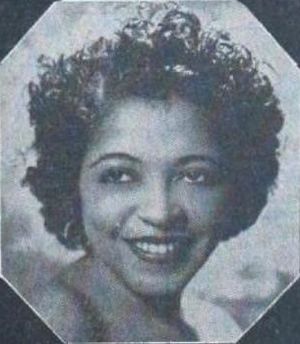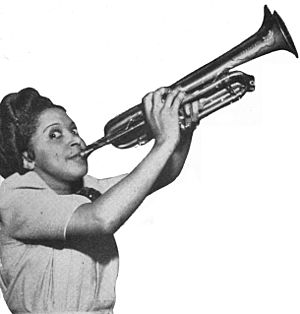Valaida Snow facts for kids
Quick facts for kids
Valaida Snow
|
|
|---|---|

Snow in a 1945 advertisement
|
|
| Background information | |
| Born | June 2, 1904 Chattanooga, Tennessee, U.S. |
| Died | May 30, 1956 (aged 51) New York City, U.S. |
| Genres | Jazz |
| Occupation(s) | Musician, entertainer |
| Instruments | Trumpet |
Valaida Snow (born June 2, 1904 – died May 30, 1956) was an amazing American jazz musician. She was also a fantastic entertainer who performed all over the world. People called her "Little Louis" and "Queen of the Trumpet." The famous musician W. C. Handy gave her the "Queen of the Trumpet" nickname.
Contents
Early Life and Talents
Valaida Snow was born in Chattanooga, Tennessee. Her mother, Etta, was a music teacher. Her father, John, was a minister and led a group called the Pickaninny Troubadours. This group mostly had child performers.
Valaida grew up traveling with her show-business family. She started performing with her father's group when she was just five years old. By the time she was 15, she could play many instruments. These included the cello, bass, banjo, violin, mandolin, harp, accordion, clarinet, trumpet, and saxophone. She was also a talented singer and dancer!
Becoming a Star
Valaida started her solo career by joining a popular show called Holiday in Dixieland. Later, she performed regularly at a club in Harlem. This helped her get a role in the musical In Bamville. She starred alongside the famous Josephine Baker. Even though the musical wasn't a huge hit, both Valaida and Josephine got great reviews.
Valaida decided to focus on playing the trumpet. She quickly became so good that people nicknamed her "Little Louis." This was after Louis Armstrong, who was a legendary trumpet player himself. Armstrong even said Valaida was the second-best jazz trumpet player in the world, after him! W. C. Handy, known as the "Father of the Blues," called her the "Queen of the Trumpet."
In 1928, Valaida gave an amazing performance in Chicago. She played the trumpet, sang, and then danced in seven different pairs of shoes! She danced in soft-shoe, tap, Dutch clogs, and even Russian boots. Louis Armstrong was there and clapped for a long time. He said, "Boy, I never saw anything that great!"
Even with her amazing talent, Valaida mostly toured around the world. She played concerts across the U.S., Europe, and China. In 1926, she toured London and Paris. Then, from 1926 to 1929, she performed in places like Shanghai, Singapore, Calcutta, and Jakarta.
International Success
The 1930s were Valaida's most successful years. She became very popular in London and Paris. During this time, she recorded her hit song "High Hat, Trumpet, and Rhythm." She also performed in the Ethel Waters show Rhapsody in Black in New York.
In the mid-1930s, Valaida made films with her husband, Ananias Berry. He was part of the famous Berry Brothers dancing group. After performing at the Apollo Theater in New York City, she went back to Europe and the Far East for more shows and films.
Later Years and Legacy
During World War II, Valaida was touring in Denmark. She was arrested by soldiers and held in a prison in Copenhagen. She was later released in a prisoner exchange in May 1942. This experience was very difficult for her.
In the 1950s, Valaida found it hard to get back to her earlier level of success. She passed away on May 30, 1956, at the age of 51. She died backstage during a performance in New York City.
Many recordings of Valaida Snow's performances still exist. These include audio and video recordings of her on stage and in films. Music professor Tammy L. Kernodle said that Valaida was a very respected musician. She was admired by other jazz musicians, even though not as many of her performances were recorded compared to some of her peers.
Valaida Snow's legacy is important because she helped change jazz music. She also helped people understand how jazz spread to Europe after World War I.
Notable Performances
- March 11, 1933: Valaida Snow performed with Earl Hines in Harrisburg, Pennsylvania.
- September 23, 1945: She performed at the First Cavalcade of Jazz concert in Los Angeles. This concert also featured Count Basie and Big Joe Turner.
In Literature
Valaida Snow's life has inspired several books and comics:
- Earl Hines' autobiography, The World of Earl Hines, includes stories about Valaida.
- A novel based on her life story has been written.
- A comic strip about her life, titled Valaida Snow, was published in Paris in 2012.
Discography
- 1940–1953 (Classics)
- Queen of Trumpet and Song (DRG, 1999)
See also
 In Spanish: Valaida Snow para niños
In Spanish: Valaida Snow para niños


